Nori Bento (Roasted Seaweed on Rice) is a classic bento consisting of just rice, bonito flakes, soy sauce and roasted seaweed. But I added Saikyo Yaki Fish and other dishes to make it more nutritious. The flavour of nori and bonito flakes is so good that you can eat just rice without other dishes.
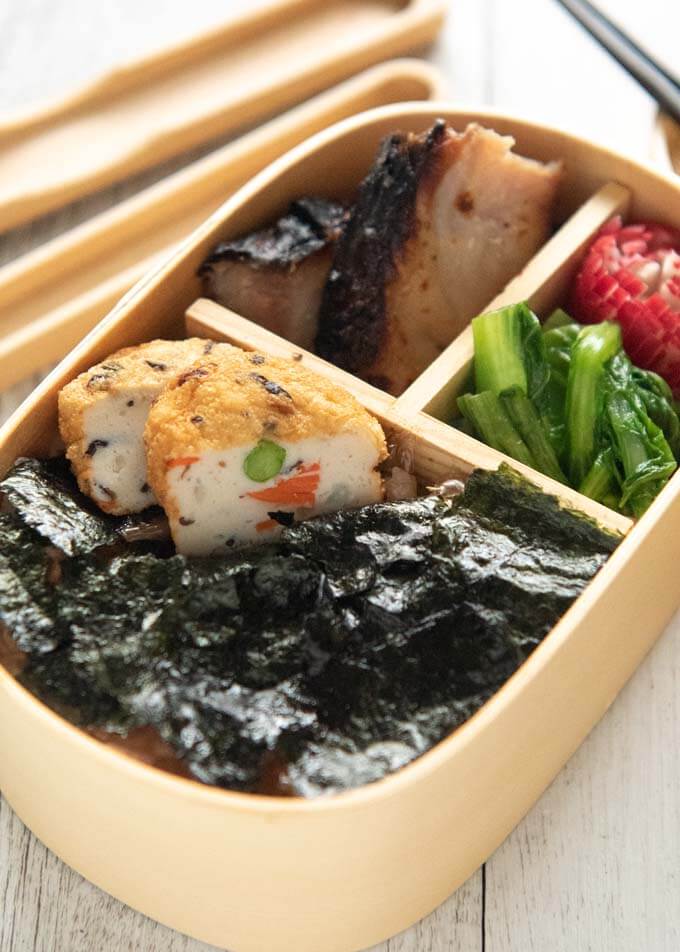
For the people who are new to this simple bento, I decided to call it Nori Bento to indicate that it is a bento and the main ingredient is nori (roasted seaweed). But it is actually called ‘Noriben’ (海苔弁 orのり弁) in Japan, by shortening the two words ‘nori’ (海苔 orのり) and ‘bento’ (弁当).
It is said that Noriben was officially introduced to consumers in 1980 by a bento company. The bento consisted of roasted seaweed sheet, bonito flakes and soy sauce on rice, topped with fried fish and fish cakes.
But by 1955, Noriben was already wide spread among Japanese households. I clearly remember taking Noriben to school in the 1960s. At the time, the rice topped with bonito flakes and nori occupied most of the bento space with only a small amount of protein and vegetables. Well, there wasn’t an abundance of food in those days.
Definition of Nori Bento aka Noriben
Noriben is a bento that contains rice topped with bonito flakes and soy sauce, covered with nori (roasted seaweed sheet). Whether or not other dishes are added to the bento does not matter.
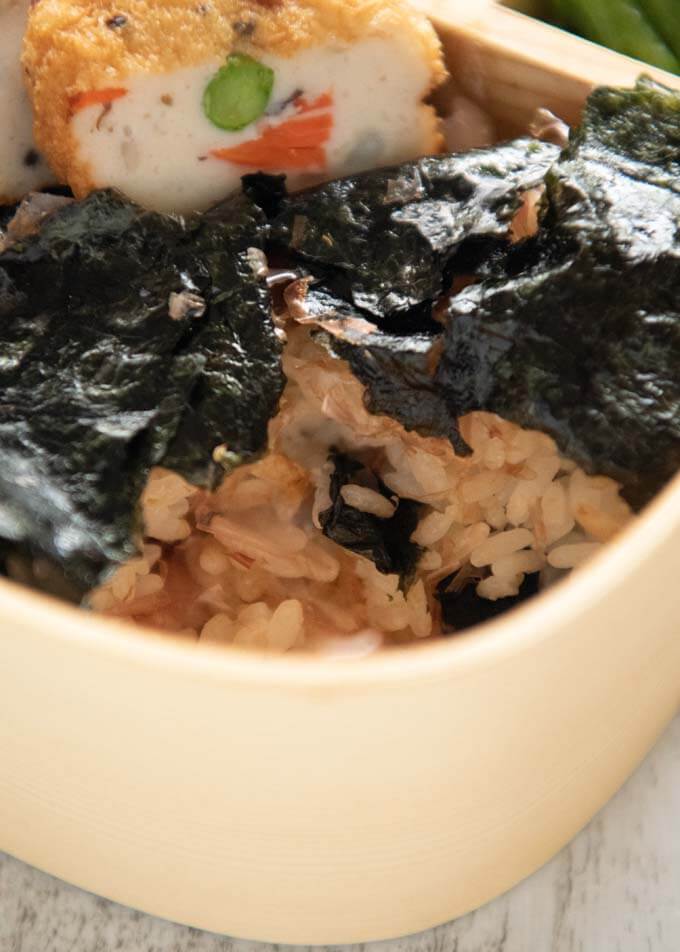
As long as the rice component meets the above definition, we call it Noriben. Even if the rice compartment is much smaller than the others, you can call it Noriben if you wish.
The original Noriben came with just one layer of bonito flakes, soy sauce and nori. But people became more creative. See the section Noriben Variations in this post for more details.
What’s in My Nori Bento
My bento consists of the Noriben component and other dishes.
Noriben Component:
Cooked rice – please refer to How to Cook Rice the Japanese Way. It is best to cook the rice for bento fresh in the morning if possible, but it can be made ahead.
Nori (Roasted seaweed) – the size of the nori sheet depends on the surface area of the rice. The idea is to cover the rice with nori completely.
Bonito flakes – the quantity of bonito flakes depends on the surface area of the rice.
Soy sauce – the quantity of soy sauce depends on the amount of rice. You will only need to wet the bonito flakes and nori sheet if you wish.
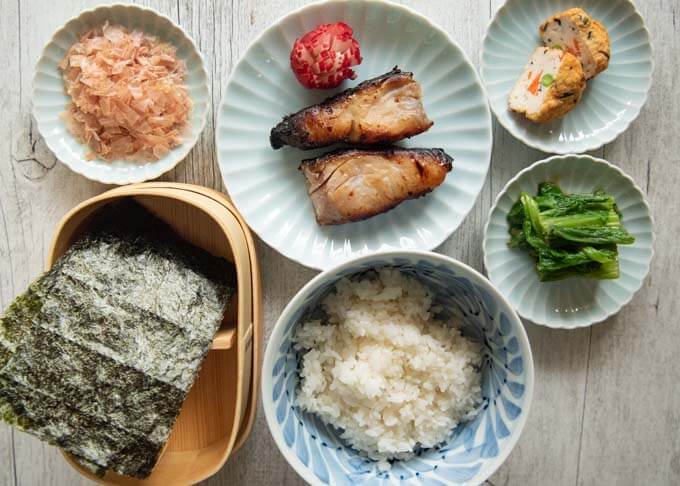
Other dishes:
Saikyo Yaki Fish – I used Spanish mackerel but you can marinate salmon or other fish suitable for Saikyo Yaki. You need to marinate the fish for 1-3 days before grilling. I usually freeze the marinated fish so that I can cook it any time. My bento box was small so I halved the fish to fit in a small compartment in the bento box. If you wish, you can place the fish on the Noriben too.
Japanese Fried Fish Cake (Satsuma Age) – make ahead. You can even freeze it. To defrost, leave it on the kitchen bench to thaw naturally or use a microwave. Do not overheat in the microwave as the fish cakes will explode. You could grill frozen fish cakes over medium low heat to heat up, too.
Gai choy Karashi-ae – I used the recipe, Broccolini Karashi-ae (Mustard Dressing). Instead of broccolini, I used gai choy (Chinese mustard greens). Alternatively, you can use other greens such as green beans, spinach, Chinese broccoli, etc.
Pickled Chrysanthemum Radish – this needs to be made ahead. I needed the bright red colour to lighten up the bento as the rice compartment is black. You can add red tomatoes as an alternative.
You can eat the rice without these dishes because the rice is already flavoured. But I added a small amount of grilled Saikyo Yaki Fish and other dishes to make the bento a more balanced meal. You don’t need to pack the same dishes and you can even reduce the number of dishes.
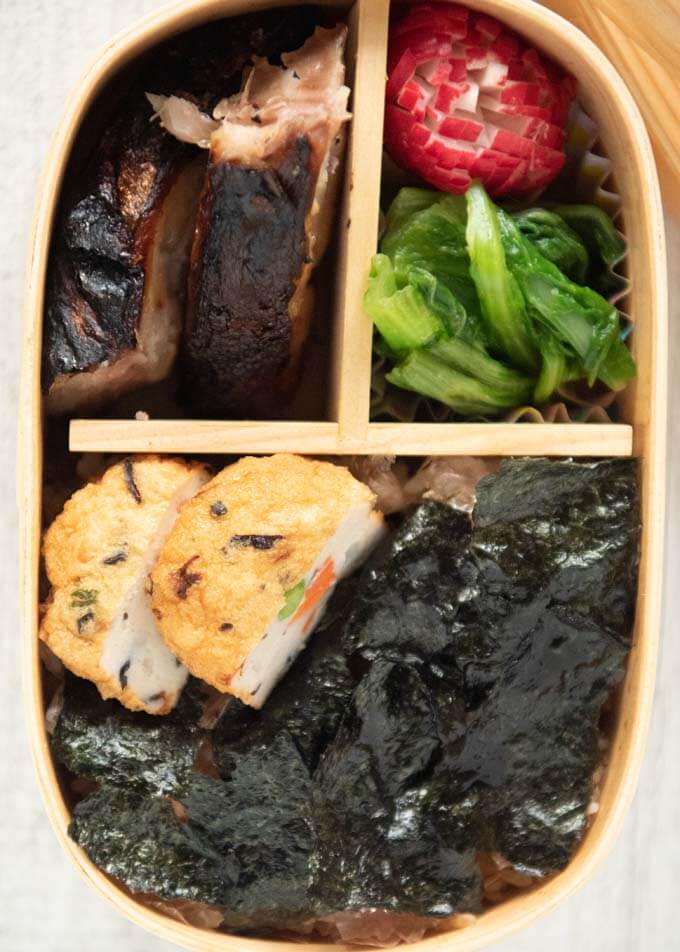
How to Make Noriben
The traditional way of making Noriben is simple. Put rice in a bento box, spread bonito flakes, dribble soy sauce and place a sheet of nori over the rice. Sometimes you dribble soy sauce on nori as well.
As the quality of nori improved, I found that the nori sheet on the rice does not break easily with chopsticks because it is soggy. When I tried to eat the rice with bonito flakes and nori together, I often dragged the entire sheet of nori, leaving the remaining rice with just bonito flakes.
Since then, I have changed the way I place the nori sheet. My way of making Noriben is as follows:
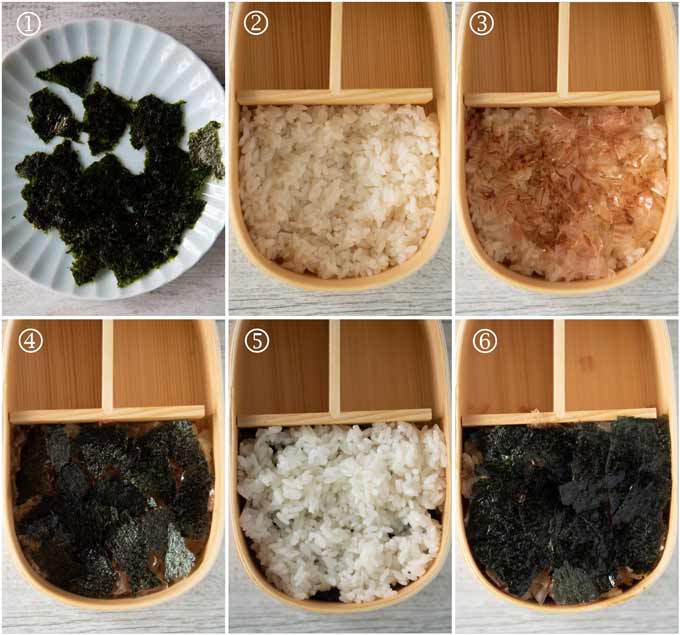
- Tear the sheet of nori into smaller pieces.
- Spread rice to half the depth of the bento box.
- Scatter bonito flakes over the rice and dribble soy sauce over the bonito flakes.
- Spread nori pieces over the rice and dribble soy sauce.
- Spread rice over the nori pieces.
- Repeat bonito flakes and nori pieces.
I made two layers of noriben but if you make just one layer, fill the rice almost to the top of the bento box and omit steps 5 and 6.
Dribbling soy sauce is a bit of challenge. You don’t want to add too much soy sauce, but you want to add enough to wet the bonito flakes and give a flavour to the rice.
To control the amount of soy sauce to dribble while evenly wetting the bonito flakes, I use a small soy sauce spray bottle. It’s just like any spray bottle but the size is so small and compact, it is perfect to carry around for picnics, etc.
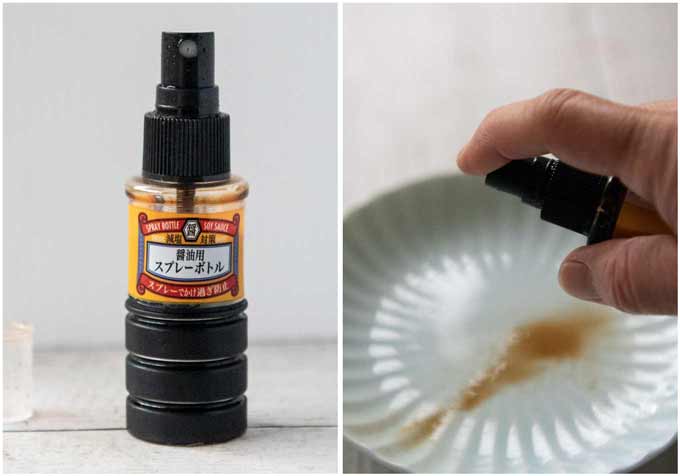
I bought it in Japan but Amazon sells it and you might also find it at Daiso discount shops. It’s really a handy bottle. I sometimes use it when I eat sushi too.
The step 5 to dribble soy sauce over the nori is optional, especially if you feel that you used enough soy sauce over the bonito flakes.
Noriben Variations
Tearing/cutting the nori sheet: The original Noriben is made with a sheet of nori. So, tearing a nori sheet into smaller pieces is one of the variations. Instead of tearing, you can cut them neatly if you wish or use strips of nori pieces to cover the rice.
Double-decker Noriben: When the rice compartment has a sufficient depth, you can make two layers of Noriben. Double decker Noriben means he entire rice bas a good flavour, because of the extra layers.
Vertical Noriben: Someone must have invented this Noriben to address the potential problem of having a large sheet of nori (as described in the previous section), as well as giving a sufficient amount of Noriben flavour to the entire rice. Instead of placing bonito flakes and a sheet of nori on top of rice, Vertical Noriben is made by inserting small nori sheets with bonito flakes vertically at certain intervals.
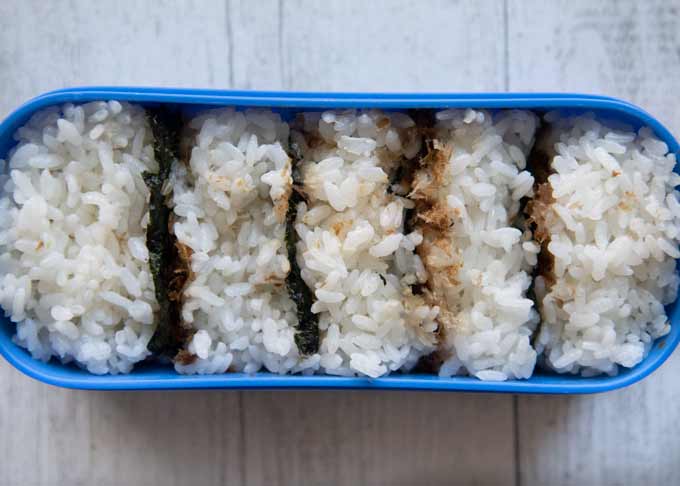
I applied the first two variations to my bento today.
Nori Bento (Roasted Seaweed on Rice), aka Noriben, is a great way of packing a bento when you don’t have many dishes to go in it. Just like the bento company that officially introduced Noriben, you can just place one main dish on the nori sheet and it’ll be quite tasty.
Yumiko![]()
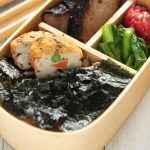
Nori Bento (Roasted Seaweed on Rice) is called Noriben in Japan. It is a classic bento consisting of just rice, bonito flakes, soy sauce and nori (roasted seaweed) . But I added fish and vegetable dishes to make it more nutritious.
Because bento is usually made mostly from left-over dishes or make-ahead dishes, the time indicated in this recipe only shows the time to pack the bento box.
- 1 cup cooked rice (note 1)
- 2 sheets nori (roasted seaweed) the same size as the rice surface area (note 2)
- 2.5g / 0.09oz bonito flakes (note 3)
- Soy sauce
- 1 Spanish Mackerel Saikyo Yaki halved (note 4)
- 1 Japanese Fried Fish Cake (Satsuma Age) cut in half diagonally (note 5)
- 30g / 1.1oz Karashi-ae with gai choi/Chinese mustard greens (note 6)
- 1 Pickled Chrysanthemum Radish
- A bento box of your choice
- 1 okazu cup (note 7)
-
Tear the nori sheets into smaller pieces.
-
While the rice is still hot or warm, place ½ of the rice in the largest compartment of the bento box. Level the surface.
-
Spread ½ of the bonito flakes and dribble soy sauce (note 8) to wet the bonito flakes.
-
Spread ½ of the nori pieces covering the rice and bonito flakes as much as possible. Dribble/spray a small amount of soy sauce over the nori.
-
Put the remaining rice on top of the nori and level the surface.
-
Repeat the step 3 and 4.
-
In one of the empty compartments, place Saikyo Yaki fish pieces.
-
Put Karashi-ae in an okazu cup and place it in the corner of the other empty compartment.
-
Place Pickled Chrysanthemum Radish next to Karashi-ae.
-
Put Japanese Fried Fish Cake on Noriben in the corner (note 9).
1. It is best to pack cooked rice in a bento box while hot or warm as it is easier to shape the rice into the bento box.
2. If you are making a single layer Noriben, you only need 1 sheet.
3. A small plastic packet usually contains 2.5g / 0.09oz of bonito flakes. You can increase the amount of bonito flakes if you like.
4. I halved the fish after grilling so that it fits in my bento box. If your bento box is large, you can pack a whole piece.
5. Make ahead, left over from the meal, or even use a frozen fish cake. If using a frozen fish cake, leave it on the kitchen bench to thaw naturally or use a microwave to defrost. Do not overheat in the microwave as fish cakes will explode. You could grill frozen fish cake over medium low heat to heat up, too.
6. Please use the recipe Broccolini Karashi-ae (Mustard Dressing) and use blanched gai choy/Chinese mustard greens cut to 4cm / 1½” long instead of broccolini.
7. Instead of an okazu cup, you can use a cupcake liner or a small sheet of aluminium foil to separate the two items.
8. I spray soy sauce using a soy sauce spray bottle. See the sample photo of a soy sauce spray bottle in the post. I bought it in Japan but Amazon sells it and you might also find it at Daiso discount shops. It’s a really handy little bottle when you want to control the amount of soy sauce and evenly spread it over the food.
9. I didn’t have room to put the fish cake pieces in the dish area so I placed them on Noriben. You don’t need to do this if you have more room to pack the fish cakes.
I’m grateful. You improve my family’s perception of me. My young child asked whether I was attending culinary school.
Hi Barbara, what a complement from your child!
Made this is total WOW Everyone thoroughly enjoyed their meal. I appreciate it. YOU help my family see me in a better light. My little child inquired as to my enrollment in culinary school.
Hi Paragon, that’s wonderful! You little one’s inquiry made me smile.
I love the Japanese food this recipe is good to try. I remember it looks like the nori bento I have tried before. Thanks
Hi Tricia, please let me know what you thik.
This is one of my favourite lunches… I feel a special connection to your family as I also moved to Canada in 1981, I was 9 at the time. My mom also cooked & prepared many Japanese food for us when Japanese food wasn’t cool yet. I’m a mom of a teenager now and she also loves all Japanese food. Some of her top Japanese foods she loves are natto (I make my own) & katsuobushi gohan. Thanks to you & Nagi for always posting great recipes!
Hi Michiyo. Indeed, the timing of migration is really similar! Canada was another candidate for our destination but at the time, a company sponsorship was required.
You make you own natto? Wow, that’s impressive!
A friend taught me how to “make“ natto… I use a package of store bought natto, mix with cooked soybeans at home. I let it ferment for a day… I use something called Nabe-boushi 鍋帽子 works like a charm ! And now we can eat natto in a big huge bowl without worrying about $$!
hi Michiyo, I might try that.
Is this really just called “Nori bento” ie just Seaweed Bento?? (Looks YUM just checking the NAME!)
The real name is Noriben. The term ‘seaweed’ implies wakame seaweed, while ‘nori’ as roasted seaweed is widely known these days.
just made this! WOW!…everyone really enjoyed it for lunch…thank you …YOU make me look great to my family!..my young son asked me if I was going to cooking school now
Hi Marg, your are soo quick to action and it’s wonderful. now you’ve got a high expectation from your family!